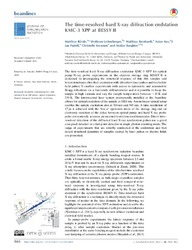The time‐resolved hard X‐ray diffraction endstation KMC‐3 XPP at BESSY II
Rössle, Matthias
Leitenberger, Wolfram
Reinhardt, Matthias
Koç, Azize
Kwamen, Christelle
Rössle, Matthias; Leitenberger, Wolfram; Reinhardt, Matthias; Koç, Azize; Pudell, Jan; Kwamen, Christelle; Bargheer, Matias, 2021: The time‐resolved hard X‐ray diffraction endstation KMC‐3 XPP at BESSY II. In: Journal of Synchrotron Radiation, Band 28, 3: 948 - 960, DOI: 10.23689/fidgeo-4276.
 |
Dokument öffnen: |
The time‐resolved hard X‐ray diffraction endstation KMC‐3 XPP for optical pump/X‐ray probe experiments at the electron storage ring BESSY II is dedicated to investigating the structural response of thin film samples and heterostructures after their excitation with ultrashort laser pulses and/or electric field pulses. It enables experiments with access to symmetric and asymmetric Bragg reflections via a four‐circle diffractometer and it is possible to keep the sample in high vacuum and vary the sample temperature between ∼15 K and 350 K. The femtosecond laser system permanently installed at the beamline allows for optical excitation of the sample at 1028 nm. A non‐linear optical setup enables the sample excitation also at 514 nm and 343 nm. A time‐resolution of 17 ps is achieved with the `low‐α' operation mode of the storage ring and an electronic variation of the delay between optical pump and hard X‐ray probe pulse conveniently accesses picosecond to microsecond timescales. Direct time‐resolved detection of the diffracted hard X‐ray synchrotron pulses use a gated area pixel detector or a fast point detector in single photon counting mode. The range of experiments that are reliably conducted at the endstation and that detect structural dynamics of samples excited by laser pulses or electric fields are presented. The KMC‐3 XPP endstation of the synchrotron BESSY II is dedicated to time‐resolved studies of structural dynamics of matter upon optical and/or electrical excitation using hard X‐ray diffraction with an accessible time range from 17 ps to several microseconds.
image
Statistik:
ZugriffsstatistikSammlung:
Schlagworte:
beamline instrumentationtime‐resolved X‐ray diffraction
optical excitation
thermal transport
ferroelectric switching
This is an open access article under the terms of the Creative Commons Attribution License, which permits use,
distribution and reproduction in any medium, provided the original work is properly cited.

